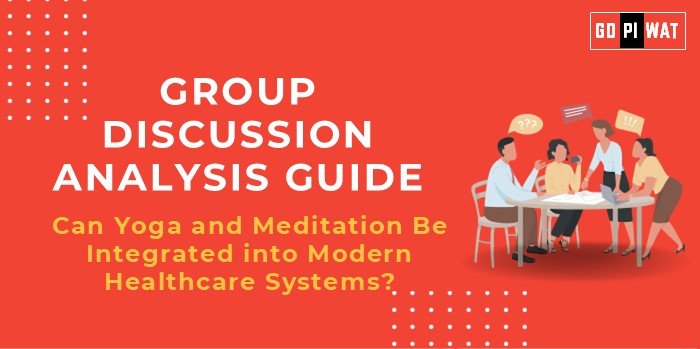📋 Group Discussion (GD) Analysis Guide: Can Yoga and Meditation Be Integrated into Modern Healthcare Systems?
🌟 Introduction to the Topic
- Opening Context: Yoga and meditation, ancient practices rooted in holistic well-being, have recently gained prominence in healthcare, demonstrating profound impacts on mental and physical health. Their integration into modern systems reflects a shift toward preventive and patient-centered care.
- Topic Background: Originating in ancient India, yoga and meditation focus on mental and physical harmony. Modern research highlights their benefits in stress reduction, chronic disease management, and mental health support. Countries like the U.S. have embraced these practices within healthcare models, showing promising outcomes.
📊 Quick Facts and Key Statistics
- 🧘♀️ Mental Health Benefit: Meditation reduces anxiety and depression symptoms by up to 60% (National Institutes of Health, 2023).
- 💰 Cost-Effectiveness: Yoga-based therapies lower healthcare costs for chronic conditions by 20% (WHO, 2023).
- 🌍 Global Acceptance: Over 80 countries now recognize yoga as a complementary therapy (UNESCO, 2023).
- 🏢 Corporate Wellness: 65% of Fortune 500 companies include yoga in employee wellness programs (Harvard Business Review, 2023).
🔗 Stakeholders and Their Roles
- 🏥 Healthcare Systems: Develop integrative care models incorporating yoga and meditation.
- 🏛️ Government Bodies: Promote initiatives like International Yoga Day to raise awareness.
- 🧪 Practitioners and Researchers: Provide evidence-based programs and conduct clinical trials.
- 👥 Patients: Actively participate in holistic treatment plans.
- 🌐 Global Organizations: WHO advocates yoga and meditation for non-communicable disease management.
🏆 Achievements and Challenges
✨ Achievements:
- 💡 Health Outcomes: Significant reduction in stress-related disorders and cardiovascular risks.
- 📜 Policy Recognition: Inclusion in India’s AYUSH programs and WHO endorsements.
- 🔬 Research Growth: Over 5,000 studies in 2023 supported their therapeutic efficacy.
⚠️ Challenges:
- 📏 Standardization Issues: Lack of uniform certification for practitioners.
- 🌐 Cultural Perceptions: Resistance in regions unfamiliar with these practices.
- 💸 Economic Barriers: Limited access in lower-income areas.
Global Comparisons:
- 🇺🇸 U.S.: Medicare covers yoga for chronic pain.
- 🇸🇪 Sweden: Meditation is integrated into public mental health services.
Case Studies:
- 🇮🇳 India: AIIMS uses yoga in rehabilitation programs for diabetes.
- 🇦🇺 Australia: Mindfulness initiatives in schools reduce student anxiety by 30%.
💡 Structured Arguments for Discussion
- Supporting Stance:
“Integrating yoga and meditation enhances patient outcomes and reduces healthcare costs.” - Opposing Stance:
“The lack of regulation and evidence in some areas raises concerns about safety and efficacy.” - Balanced Perspective:
“While yoga and meditation show potential, challenges in implementation and cultural acceptance remain.”
🎯 Effective Discussion Approaches
- Opening Approaches:
- 🧠 “With a 60% reduction in anxiety through meditation, how can healthcare overlook such impactful solutions?”
- 🌿 “Incorporating holistic practices in modern healthcare bridges gaps in preventive care.”
- Counter-Argument Handling:
- 📜 Address safety concerns by citing regulated programs like AIIMS initiatives.
- 💰 Rebut cost issues by emphasizing their affordability compared to conventional treatments.
📈 Strategic Analysis of Strengths and Weaknesses
- 💪 Strengths: Cost-effective, non-invasive, globally recognized.
- 🛑 Weaknesses: Regulatory gaps, limited evidence in some areas.
- 🌟 Opportunities: Growing demand for holistic healthcare.
- ⚠️ Threats: Misuse by unqualified practitioners.
🎓 Connecting with B-School Applications
- 📌 Real-World Applications: Explore yoga’s integration into corporate wellness strategies or public health policies.
- 🧐 Sample Interview Questions:
- 💬 “How can yoga enhance healthcare delivery in resource-limited settings?”
- 📱 “Discuss the scalability of mindfulness practices in healthcare.”
- 💡 Insights for B-School Students:
- 💰 Investigate cost-saving implications for public health budgets.
- 📱 Study the role of technology in spreading these practices (e.g., mindfulness apps).


